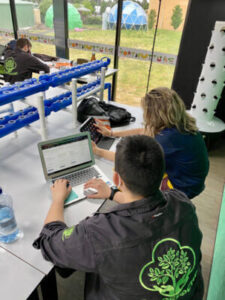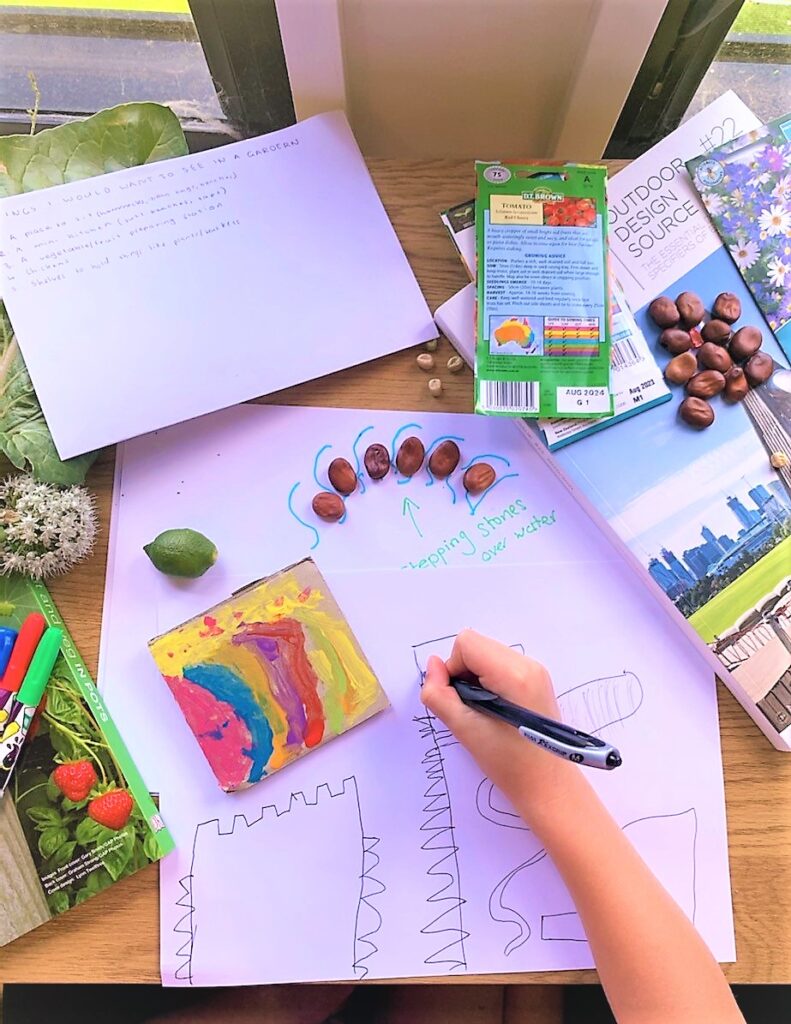
Involving children in the design and planning of greenspaces
By Dr Kate Neale and Michael Casey –
Schools are increasingly recognising that greenspaces provide students with important access to nature, wellbeing, shelter, places of retreat, integrated learning contexts and aesthetic appeal. As such, schools are increasingly engaging with landscape professionals who consult with principals, P&C committees and educators to establish the vision for a space, needs of the cohort and practical design elements. For professionals who engage meaningfully with students, this involves privileging their perspectives as the intended beneficiaries of the landscape design.
Co-design is the act of creating with others (as opposed to for others) in a way that values an intended user’s needs and lived experience, whilst maximising opportunities for them to actively participate in the design process. It continues throughout the lifecycle of a project in refining and re-designing as the project comes to fruition. Co-design inherently shifts power away from those with technical expertise towards the applied knowledge and experience that intended users hold. The main objective is to hear and understand what the users of these spaces want to see in the completed project. For schools, this both maximises the potential benefits greenspaces bring to children and activates the benefits that arise through the process of their inclusion.
Designing alongside children creates the conditions for them to develop and practice important social skills such as understanding democratic processes, capacity building, resilience, teamwork, communication skills, problem-solving and active listening. Negotiating these processes and spaces with others in a respectful and meaningful way instils a sense of social inclusion and cohesion – all important pillars for a sense of belonging and place. In addition, within this integrated learning environment, children learn about (and subsequently benefit from) environmental pro-behaviour, biodiversity, sustainability, science, mathematics, play, artistic expression, design and of course, horticulture.

for a school garden (Image: Kate Neale)
As co-designers, children contribute to the design process as experts of their own lives. By using methods to capture children’s self-expression, designers can gain rich insights into their previous and imagined uses of spaces, whilst overlaying these ideas with those of other important stakeholders whose ideas are also important to the project. These views iteratively inform the design as it progresses throughout the project phases.
There are a number of methods available to designers wishing to co-design with children and they are best chosen to suit the project and the students involved. Children are not a homogenous group, so it is important to capture the voices of a range of children. It is also important to ensure the whole school cohort has been given the opportunity to participate, if not in the entire design process or overall design, then at least in aspects most relevant or appropriate to them.
Walk and talk tours (real or virtually) can fuel inspiration for school ground design. Thinking outside the school garden and discussing design elements in home gardens, parks, public spaces, or even indoor spaces, allows children to draw on what feels familiar, inviting and safe, and adds unexpected creature comforts to a school setting. Doing so, has the potential to increase a child’s connection to place and sense of security and belonging – important pillars of wellbeing.
Imaginative ‘Blue-sky dreaming’ sessions are successful where students may feel uncertain about the process but are reminded everyone knows how to imagine and there are no silly ideas. Children usually enjoy the fluidity and lack of constraint that comes with this process and whilst delivering on children’s wildest dreams may not be possible, the process helps unpack the essence of what is important to them which may be implemented in a more practical way. Ultimately, it is important to seek and trust children’s perspectives and delve deeper to understand what their suggestions mean, as it is likely to help you navigate compromises in the design whilst not deviating from their core wishes.
Drawing and collage presentations are another way for even young children to participate by allowing them to engage in broader perspectives of the design. Older children may prefer to be included on finer or more complicated aspects of the design, where decision-making requires the ability to compare and negotiate through a number of considerations.
Secret ballots, one-on-one chats with designers and an anonymous ideas box allow quieter children to give their opinion and receive equal billing amongst more popular or confident students. Sharing and adopting ideas through anonymous discussions can encourage a student to stand up and lead a conversation without taking ownership for it, whilst avoiding any embarrassment if deemed unfeasible or unpopular.

Students researching landscape designs as a part
of their co-design input (Image: Michael Casey)
Delivering what has been agreed upon is critical to any project, including those with children. Most children have experienced adults not delivering, or under-delivering on promises, but that does not make it okay. Like any client, you need to give your word and deliver (don’t make promises you can’t deliver or fail to deliver on what you promised). Round table discussions and prioritised wish-lists help bring collective agreement to individual ideas and are usually successful after students have had the chance to engage in ideas, see examples, conduct research, feel confident in the process and believe their ideas will be heard. Managing expectations (and imaginations) by having options for children to choose between, instead of asking open-ended questions about what they want, helps to ensure you can deliver on their expectations whilst demonstrating their ideas have been taken seriously. These agreed ideas become a unified voice ready to present to other stakeholders, empowering students to take a leading role in a conversation and assert their voice on this project. The role of the professional here is to validate their ideas and ensure their continued involvement in design discussions alongside the adult stakeholders throughout the entire process.
The process ultimately creates better co-designed spaces that inspire children to become stewards of their new creations – increasing their sense of ownership and pride in their school grounds and making it more likely spaces will be cared for and respected by the students themselves. Reduced litter and damage to plants or infrastructure arguably reduces the burden of maintenance and upkeep for the school, making the project more cost-effective and sustainable in the long run. The benefit to professionals of this is the increased likelihood they have been able to deliver better-designed, more utilised, tailor-made and loved greenspace – increasing the success of the project and reputation of those involved.
One final note…
Although “childhood” is a constant, the children within are passers-by… spaces designed for children as a collective, will serve many individual children, but we should remain mindful of how we can continue to accommodate the views and experiences of different cohorts of children into elements of the greenspace over time.
Michael Casey is Director of Evergreen Infrastructure and MJC Horticulture, National President of Australian Institute of Horticulture and currently sits on the council with Therapeutic Horticulture Australia. president@aih.org.au or michael@evergreeninfrastructure.com.au
Dr Kate Neale holds concurrent fellowships at the Centre for Children and Young People at Southern Cross University and the Centre for Urban Greening and Ecology, Singapore National Parks. She specialises in the therapeutic benefits of horticulture for children, and people with disability. She is also the Vice President of Therapeutic Horticulture Australia. Her work can be viewed at www.digability.com.au
